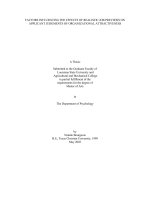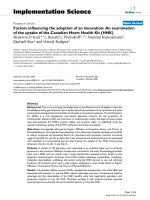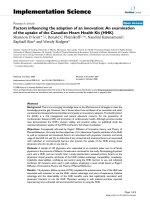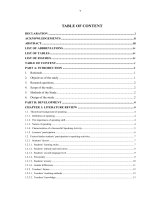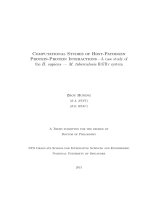Key factors influencing the participation of local households in redd program: A case study in Vietnam
Bạn đang xem bản rút gọn của tài liệu. Xem và tải ngay bản đầy đủ của tài liệu tại đây (299.22 KB, 10 trang )
Economic & Policies
KEY FACTORS INFLUENCING THE PARTICIPATION OF LOCAL
HOUSEHOLDS IN REDD+ PROGRAM: A CASE STUDY IN VIETNAM
Le Dinh Hai, Hoang Thi Lan Phuong
Vietnam National University of Forestry
SUMMARY
Nowadays, climate change is serious problem in worldwide. Deforestation of tropical forests contributes
approximately 10 - 20% of global greenhouse gas emissions. In order to build the capacity of developing
countries to encounter the challenges of reducing emissions from deforestation in developing countries
(REDD), we need find key factors influencing the participation of local household in REDD+ program. From
2009 to 2012, the Japan International Cooperation Agency combined with Vietnam Administration of Forestry
to develop REDD+ program in Dien Bien province. We conducted a survey of 150 households in Muong
Phang commune, Dien Bien district, Dien Bien province. Results of the study show that six main factors,
including: forestland area, ethnicity, concerned about forest degradation, household wealth ranking, rationality
of government payment, and number of labourers, significantly influence participation of local households to
REDD+ program in the study area. The study also indicates some potential solutions to increase the number of
people participating REDD+ program.
Keywords: Binary logistic regression analysis, ethnic communities, factors affecting participation,
UN-REDD+ Programme.
1. INTRODUCTION
Climate change is considerable problem that
the world is facing today. It influences directly
to forests and livelihood of local people who
living depend on forests. Numerous studies
have shown that deforestation and forest
degradation result in the emission of about
17.3% of greenhouse gases in all economic
sectors (IPPC, 2007). REDD (reducing
emissions from deforestation and forest
degradation) incentivises a break from historic
trends of increasing deforestation rates and
greenhouse gases emissions. It is a framework
through which developing countries are
rewarded financially for any emissions
reductions achieved associated with a decrease
in the conversion of forests to alternate land
uses (Parker et al, 2009). REDD+ strategies go
beyond deforestation and forest degradation, it
includes the role of conservation, sustainable
management of forests and enhancement of
forest carbon stocks in reducing emissions.
Implementation of the REDD+ program
will have significantly environmental and
socio-economic benefits, especially for
mountainous rural areas. Local people cannot
leave away from forests. It is concerned by
scientists to find the viable solutions to ensure
the life of people who living near forests. The
154
factors that affect the participation and nonparticipation of people in REDD+ program are
questions posed to forest managers. Thus,
REDD+ program is implemented in many
developing countries including Vietnam. That
is machinery planned to offer finance rewards
for ensuring forests are going to provide stable
benefits.
Recognizing that "responding to climate
change is vital," the Government of Vietnam
issued Decision 799/QD-TTg (June 27, 2012)
approving the National Action Program on
REDD+ (Nguyen Tan Dung, 2012). It specifies
that Vietnam will endeavor to limit
deforestation
and
forest
degradation,
sustainable management of forest resources to
reduce greenhouse gas emissions and improve
forest carbon stocks, and conserve biodiversity
along with eradicating hunger and poverty
reduction and sustainable development.
Decision 799/QD-TTG also allows Ministry of
Agriculture & Rural Development (MARD) to
select at least eight provinces with high
greenhouse gas emission reduction potential
and represent eco-regions participating in
REDD+ pilot projects, in line with conditions,
including Muong Phang commune, Dien Bien
district, Dien Bien province. Once REDD+
programs are implemented, forest land will be
JOURNAL OF FORESTRY SCIENCE AND TECHNOLOGY NO. 7 (2019)
Economic & Policies
delivered to local people, especially ethnicities
by the government. Owners of forests may be
receive money for environmental benefits
provided by the vegetation, and they can
borrow the money from REDD+ program for
their breeding instead of totally depending on
forests. In addition, their management is
necessary to implement the methods of
restoring and increasing carbon stocks as well
as providing a cheap but effective form to
control forests. The participation of local
people play an important role in the success of
REDD+ program. Objective of this study is
identify key factors that significantly influence
decisions of local households to participate in
REDD+ program in Muong Phang commune,
Dien Bien district, Dien Bien province.
2. RESEARCH METHODOLOGY
2.1. Study area
Muong Phang Commune is located to the
east-southeast of Dien Bien district with the
natural area of 3,456 ha. The total forest area of
Muong Phang commune is 1,369.6 ha, of which
special-use forests and production forests
account for 1,185.9 ha and 183.7 ha
respectively. Up to now, Muong Phang
commune has been conducting zone for
regeneration with total area of 100.4 ha signed
with forest protection and management board of
Dien Bien province. Muong Phang commune
has a tropical monsoon climate with two distinct
seasons - the rainy and hot season lasts from
April to October, and the dry season is from
November to March of the following year.
Muong Phang commune has 1026
households with the total population of 4843
people. The commune includes 26 villages.
The main ethnic composition includes Thai,
H’Mong. Survey data conducted in April 2013
showed that the proportion of working age
accounted for 57% of total population. In
general, most of the households in the
commune are living in a low economic
condition. Households belonging to the middle
income group account for 57.2% of the total
number of households in the commune;
similarly, households belonging to poor, near
poor and better off household groups account
27.4%, 10.4% and 5% of the total number of
households respectively.
Figure 1. Muong Phang commune
(Source: People Committee of Muong Phang commune, 2017)
JOURNAL OF FORESTRY SCIENCE AND TECHNOLOGY NO. 7 (2019)
155
Economic & Policies
Infrastructure of Muong Phang commune
has only met some basic requirements of life.
The villages have asphalt roads, creating some
convenience for connecting and transporting
among villages. Almost of all households have
been using electricity supplied by the national
grid and a large number of households have
access to water supplied by public water
systems.
The products that local people collected from
forests include firewood, timber and non-timber
forest products (NTFPs) such as bamboo
shoots, fruits, honey, medicinal plants and wild
vegetables for serving local demand and selling
them for tourists. This is also a good way to
increase the income for local people.
2.2. Study methods
One hundred and fifty households were
selected for survey according to the criteria in
Social capital
- Norms and values
- Information, trust and
norms of reciprocity.
table 1. The attributes of the selected
households are summarized in table 1. The
survey was based on the conceptual model for
assessing key factors affecting the decision of
households participating in REDD+ program
(Figure 2). According to Lingani (2011), the
factors influencing forest management
programs are shaped by the structure of
incentives for the members, which is affected
by the context. The context, in turn, is defined
as (1) the social network system (norms,
values, and social capital), (2) members' socioeconomic and demographic attributes (gender,
age, level of education and income, etc.) and
(3) the internal and external institutional
context. REDD+ is a program that provides an
incentive for local people to manage forests
sustainably. Therefore, this study follows the
three groups of factors mentioned in figure 2.
Socioeconomic and
demographic
attributes
Formal
institutions
Age, educational
level, residence
status, income level,
land tenure status.
Policy of forest
support
programs, land
and tree property
rights.
Participating of local people to
REDD+ program
Figure 2. Factors influence to the participation to REDD+ program
(Source: Modified from Coulibaly et al. (2011), and Boissiere et al (2014))
The survey covered a questionnaire designed
to collect data on general household
characteristics, factors influencing the decision of
household participating in REDD+ program. A
copy of the questionnaire is available on request.
Face-to-face survey was conducted in the
research. This method allows researchers the
156
opportunity to ask more questions, longer
questions, more detailed questions, more openended questions, and more complex or technical
questions. Moreover, face-to-face survey also
offers advantages in terms of data quality
(Manurung et al. 2008). The survey was
conducted from 1st July 2016 to 30th August 2016.
JOURNAL OF FORESTRY SCIENCE AND TECHNOLOGY NO. 7 (2019)
Economic & Policies
Table 1. Survey sampling design in Muong Phang commune, Dien Bien district
Household wealth ranking
Poor
Count
%
Participation
in REDD+
program
Moderate
Count
%
Rich
Count
%
Total
Count
%
No
27
55.1
24
47.1
24
48.0
75
50.0
Yes
Total
22
49
44.9
100.0
27
51
52.9
100.0
26
50
52.0
100.0
75
150
50.0
100.0
A household survey was conducted in the
representative commune (Muong Phang
commune, Dien Bien district, Dien Bien
province). Sample size of the study is
calculated based on a formula provided by
Tabachnick and Fidell (2007) that take into
account the number of independent variables
that we wish to use: N > 50 + 8 m (where m =
number of independent variables). Because in
our conceptual model (Table 2), we have 12
independent variables, we need 146 cases. In
this study, we selected 150 households
including 75 households having decision of
tree participating and 75 households not
participating to REDD+ program; therefore,
the sample size is satisfied with requirements.
Stratified random sampling was used to obtain
representative households participating REDD+
program and household wealth ranking. The
150 households were divided into 3 sub-group
based on household wealth ranking including
49 rich households, 51 moderately well-off
1−
=
+
where:
P: Probability of the household decides to
participate in REDD+ program;
1 - P: Probability of the household decides
not to participate in REDD+ program;
Xi: Independent variables or factors.
Before conducting stepwise binary logistic
regressions, preliminary analyses were
conducted to ensure no violation of the
assumptions
of
normality,
linearity,
multicollinearity and homoscedasticity among
the variables. Factors were entered into the
households and 50 poor households (Table 1).
IBM SPSS Statistics 23 was used for data
analysis. Bivariate analysis was used to
identify association between ‘decision by
households participating in REDD+ program’
(dependent variables) and factors (independent
variables). Table 2 provides a full list of
variables included in the analysis. Because the
dependent variable in the stepwise binary
logistic regression model is binary (0 or 1), the
Student’s t test was used to explore
associations with continuous independent
variables and the Pearson χ2 test was used to
explore
associations
with
categorical
independent variables. Independent variables
found to be significantly associated with
dependent variable in the bivariate analyses (p
< 0.05) were considered as candidates in
stepwise binary logistic regressions.
Binary logistic regression equation is
presented as following:
+
+ …+
stepwise binary logistic regressions if the
significance of their relationship with
dependent variable was p < 0.05 and removed
from the stepwise regressions if the
significance of their relationship with a
dependent variable became p ≥ 0.10. Factors
were entered into the stepwise regressions in
order of their correlation with an dependent
variable, from most strongly (lowest Pvalue) to
least strongly correlated (highest Pvalue) (Brace
et al. 2006; Ho 2006).
JOURNAL OF FORESTRY SCIENCE AND TECHNOLOGY NO. 7 (2019)
157
Economic & Policies
No
1
Table 2. Description of variables
Variable
Description
Ethnicity
Ethnicity of households
2
Age
Age of household head
3
Number of labours per
household
Number of labours in a
household
Household ranking
The wealth ranking of each
household
Household forestland area
Forest land area of each
household
6
Concern about forest
degradation.
The concern of local about
forest degradation
7
Education level of household
head
The number of years
households head were in
school
8
Occupation of household
head
The occupation that gave to
local people the main income.
1 = Farming;
2 = Off-farm
9
Rationality of government
payment
The rationality of payment
from the government
0 = No;
1 = Yes
Understanding about REDD+
policy
The understanding of local
people about REDD+ policy.
Some people who concern
about forest degradation but
they may not have any idea
about REDD+ and its policy.
0 = No;
1 = Yes
Total land area of households
The number of total area of
each household
Forestland area of households
Forestland area is held by
households
Where households participate
in REDD+ program
4
5
10
11
12
12
Decision of households
participating in REDD+
program
3. RESULTS
Main Characteristics of Surveyed Households
The results from Chi square Tests in Table 3
show that ethnicity (H’Mong vs. Thai),
forestland area (≤ 1 ha or > 1 ha), concerned
about forest degradation (Yes or No),
rationality of government payment (Yes or
No), and understanding about REDD+ policies
(Yes or No) were significantly correlated with
158
States
1 = Thai ;
0 = H’Mong
0 = Poor;
1 = Moderate;
2 = Rich.
0 = No;
1 = Yes
1 = ‘≤ 1 ha’;
2 = ‘> 1 ha’
0 = No;
1 = Yes
decision of households participating in REDD+
program (Yes or No) at the 5% significance
level. In contrast, household wealth ranking,
educational level of household head, and
occupation of household head were not
significantly correlated with decision of
households participating in REDD+ program at
the 5% significance level.
JOURNAL OF FORESTRY SCIENCE AND TECHNOLOGY NO. 7 (2019)
Economic & Policies
Table 3. Main characteristics of surveyed households for qualitative parameters
Decision of households participating in
Total
REDD+
Parameter
No
Count
Yes
%
Count
%
Count
%
Sig.
(Chisquare
Test)
Ethnicity
H’Mong
Thai
51
24
68.0
32.0
21
54
28.0
72.0
72
78
48.0
52.0
27
36.0
22
29.3
49
32.7
24
24
32.0
32.0
27
26
36.0
34.7
51
50
34.0
33.3
74
98.7
36
48.0
110
73.3
> 1 ha
1
Concerned about forest degradation
No
46
Yes
29
Occupation of household head
Farming
46
Off-farm
29
Rationality of government payment
No
44
Yes
31
+
Understanding about REDD policies
No
45
Yes
30
Total
75
1.3
39
52.0
40
26.7
61.3
38.7
27
48
36.0
64.0
73
77
48.7
51.3
.002***
61.3
38.7
48
27
64.0
36.0
94
56
62.7
37.3
.736NS
58.7
41.3
28
47
37.3
62.7
72
78
48.0
52.0
.009***
60.0
40.0
25
50
33.3
66.7
70
80
46.7
53.3
.000***
100.0
75
100.0
150
Note: *** p < 0.01, ** p < 0.05, *p < 0.10, NS Not significance (two-tailed tests)
100.0
Household wealth ranking
Poor
Moderate
Rich
Forestland area
≤ 1 ha
Results from Table 4 show that there were
no significant difference at the 5% significance
level for age of household head, number of
.000***
.682NS
.000***
labourers, total land area between households
decided to participate and households decided
not participate in REDD+ program.
Table 4. Main characteristics of surveyed households for quantitative parameters
Parameter
Age of household head
Number of labourers
Forestland area
Total land area
Education of HH head
Decision of households participating
in REDD+
No
Yes
Mean Std. Dev. Mean Std. Dev.
48.3
5.7 48.2
5.8
3.0
1.0
2.9
.9
.25
.17 1.22
.55
3.22
1.45 3.30
1.48
.9
1.0
6.2
1.6
Total
Mean
48.2
3.0
.74
3.26
3.5
Sig. for ttest
Std. Dev. (2 tailed)
5.7
.9
.63
1.46
3.0
JOURNAL OF FORESTRY SCIENCE AND TECHNOLOGY NO. 7 (2019)
.932NS
.665NS
.000***
.714NS
.000***
159
Economic & Policies
Decision of households participating
in REDD+
No
Yes
Mean Std. Dev. Mean Std. Dev.
48.3
5.7 48.2
5.8
3.0
1.0
2.9
.9
.25
.17 1.22
.55
3.22
1.45 3.30
1.48
.9
1.0
6.2
1.6
Parameter
Age of household head
Number of labourers
Forestland area
Total land area
Education of HH head
Total
Mean
Sig. for ttest
Std. Dev. (2 tailed)
48.2
3.0
.74
3.26
3.5
5.7
.9
.63
1.46
3.0
.932NS
.665NS
.000***
.714NS
.000***
Note: *** p < 0.01, ** p < 0.05, *p < 0.10, NS Not significance (two-tailed tests)
Key Factors Influencing Decision of Surveyed Households Participating in REDD+
Table 5. Model summary for key factors affecting decision of participating
in the REDD+ program of surveyed households
Independent variable
B
S.E.
Exp(B)
Exp(B)
adjusted
Sig. (Pvalue)
Influential
order of
factor
Constant
Ethnicity (H’Mong vs Thai)
Number of labourers
Household wealth ranking
Concerned about forest
degradation (Yes vs No)
Rationality of government
payment (Yes vs No)
-9.46***
1.60**
.625**
-1.14**
1.838
.492
.293
.367
0.00
4.98
1.87
.32
4.98
1.87
3.13
.000
.001
.033
.002
2
6
4
1.27**
.528
3.56
3.56
.016
3
.91*
.484
2.48
2.48
.060
5
Forestland area (≤ 1 ha vs > 1 ha)
5.63***
1.160
277.55
277.55
.000
1
+
Dependent variable: REDD participation decision by households (1 = Yes; 0 = No)
Number of observations
150
Omnibus tests of model coefficients:
Chi-square
95.80
df.
6
Sig.
Model Summary:
0.000***
-2 log likelihood
112.144***
Cox & Snell R square
0.472
Nagelkerke R square
0.629
Predicted percentage correct
(%)
80.0
Note: *** p < 0.01, ** p < 0.05, *p < 0.10 (two-tailed tests);
Influential order of factor with 1: highest; 6 smallest;
If B > 0 then Exp(B)adjusted = Exp(B); and if B < 0, then Exp(B)adjusted = 1/Exp(B).
Direct stepwise binary logistic regression
was performed to assess the impact of a
number of factors on the likelihood that
160
households would report that they had made a
decision of participating in the REDD+
program. The model contained six independent
JOURNAL OF FORESTRY SCIENCE AND TECHNOLOGY NO. 7 (2019)
Economic & Policies
variables (ethnicity, number of labourers,
concerned about forest degradation, forestland
area, rationality of government payment, and
household wealth ranking). The full model
containing all predictors was statistically
significant, χ2 (5, N = 150) = 95.8, p < .001,
indicating that the model was able to
distinguish between respondents who decided
and did not decide to participate in REDD+
program. The model as a whole explained
between 47.2% (Cox and Snell R squared) and
62.9% (Nagelkerke R squared) of the variance
in the decision of participation in REDD+
program in the study area, and correctly
classified 80.0% of cases.
As shown in table 5, six independent
variables (forestland area (≤ 1 ha vs. > 1 ha),
ethnicity (H’Mong vs. Thai), concerned about
forest degradation, household wealth ranking,
rationality of government payment, and
number of labourers) were statistically
significant
in
distinguishing
between
households decide or did not decide to
participate in REDD+ program. The odds of
households decide or did not decide to
participate in REDD+ program were improved
by 277.55 times if forest land area of
household greater than 1 ha, by 4.98 times if
household belongs to Thai minority ethnic
group, by 3.56 times if household has concern
about forest degradation, by 3.13 times if
wealth ranking of household decreases one
level, by 2.48 times if household has
rationality of government payment, and by
1.87 times if number of labourers in household
increase one more labourer (Table 5).
4. DISCUSSION
Forestland area
It does not come as a surprise from our
study results that the forest land area of
households is a factor affecting the decision of
villagers in participating in the REDD+. The
positive relationship between forest land area
and decision to participate in REDD+ means
that villagers are more likely to participate if
their forestland increased. Some households
who have just less than or equal 1 ha of forest
land were not inclined to participate, because
planting forest trees spent at least 5 - 6 years
for harvesting while doing agricultural
activities would have more profits. So they
decided to use their land for agriculture instead
of planting forest trees. On the other hand,
Larson (2011) and Sunderlin et al. (2014)
revealed that without secure tenure rights, local
communities are vulnerable to dispossession –
which could be a major concern if REDD+
increases land values and outside interest.
Ethnicity
Thai and H’Mong are two main ethnic
minority groups living in Muong Phang
commune, Dien Bien district, Dien Bien
province contribute strongly to the REDD+
program. Forests are in the heart of their lives
and the culture of ethnic minorities. It reflects
the culture, customs and traditional values
carried from generation to generation and the
loss of forests will be detrimental to the
community members’ spiritual lives and
traditional customs (Cromberg et al. 2014;
RECOFTC, 2010; Tauli-Corpuz, 2010).
Therefore, they are the major stakeholders in
places that implement the REDD+ program in
Vietnam.
Concerned about Forest Degradation
Local people are strongly concerned about
forest degradation. It is interesting to note that
the villagers’ awareness of REDD+ program
significantly affects the decision to participate
in the program. The more concerned about
forest degradation the more local household
participating
in
REDD+
programs.
Deforestation and forest degradation will
negatively influence livelihood of people who
live the study area and also will be main
reasons of natural disasters such as flooding in
rainy season, and drought in dry season. Local
communities committed to participate in
REDD+ program, expecting REDD+ program
could help them to protect forests effectively
(Nguyen and Rañola, 2017).
JOURNAL OF FORESTRY SCIENCE AND TECHNOLOGY NO. 7 (2019)
161
Economic & Policies
Rationality of Government Payment
Village leaders have a strong influence over
participation of local people. They are the
people who initially recognized the vital role
of forests. Village leaders prompted their
villagers to protect their land from hunters,
leading to the fact that their forests have no
change in compare with that in the past.
Village leaders shared the payment of
government equally, so most of people in their
villages were in harmony with the government
and together protected their forest (Grieg-Gran
et al. 2014). However, inequality and not
transparency of government payment are main
reasons that reduce the participation of local
villagers in REDD+ program.
Household wealth ranking
Results of the study indicated that poor and
moderate households participating more
compared with rich households. The main
reason is that rich households they focus more
on other off-farm activities while poor and
moderate households depend more on farming
and forestry activities.
Number of labourers
Results of the study indicated that the more
labour there is in the household, the greater the
probability that they will participate in REDD+
program.
Because
REDD+
requires
participants to be involved in hard working
activities such as measuring carbon
sequestration, as well as checking and
monitoring forest status regularly, only
individuals of labour age can participate in
forest protection and management.
5.
CONCLUSIONS
AND
POLICY
IMPLICATIONS
A wide range of biophysical, socioeconomic, institutional and management
factors influence the decision of households to
participate in the REDD+ program of Dien
Bien district, Dien Bien province and these
factors form a complex system of
relationships. Based on statistical analysis it
was found that forestland area (≤ 1 ha vs. > 1
ha), ethnicity (H’Mong vs. Thai), concerned
162
about forest degradation, household wealth
ranking, rationality of government payment,
and number of labourers were among the most
highly significant factors influencing the
decision of household to participate in the
REDD+ program in the study area. Therefore,
it is essential to focus on raising the awareness
of each villager, and educating them about the
importance of the land which they are
managing in REDD+ programs and forest
management. Each ethnic minority group has a
different cultural, understanding and educating
people based on their cultural would maximize
the effectiveness of the education actions in the
REDD+ program. In raising awareness of local
people to promote action, they should be
educated by realistic activities rather than
through hearing the presentation from REDD+
trainers in order to increase their willingness to
protect forest not only for their short-term
benefits but also for their future lives.
Acknowledgement
We would like to thank the many local
households and communities in Dien Bien
district, Dien Bien province that allowed us to
conducting surveys.
REFERENCES
1. Boissiere M, Beaudoin G, Hofstee C,
Rafanoharana S (2014). Participating in REDD+
measurement, reporting, and verification (PMRV):
opportunities for local people? vol 5. Forests, vol 8.
2. Brace N, Kemp R, Snelgar R (2006). SPSS for
psychologists: A guide to data analysis using SPSS for
Windows. Lawrence Erlbaum.
3. Coulibaly-Lingani P, Savadogo P, Tigabu M, Oden
P-C (2011). Factors influencing people's participation in
the forest management program in Burkina Faso, West
Africa Forest Policy and Economics 13:292-302
doi: />4. Cromberg M, Duchelle A, Rocha I (2014). Local
Participation in REDD+: Lessons from the Eastern
Brazilian Amazon Forests 5:579.
5. Grieg-Gran M, Mohammed EY, Nhantumbo I
(2014). What people want from REDD+ assessing local
views and preferences. International Institute for
Environment and Development.
6. Ho R (2006). Handbook of univariate and
multivariate data analysis and interpretation with SPSS.
Chapman & Hall/CRC.
7. Larson AM (2011). Forest tenure reform in the
JOURNAL OF FORESTRY SCIENCE AND TECHNOLOGY NO. 7 (2019)
Economic & Policies
age of climate change: Lessons for REDD+ Global
Environmental Change 21:540-549.
8. Manurung GES, Roshetko JM, Budidarsono S,
Kurniawan I (2008). Chapter 4: Dudukuhan tree farming
systems in West Java: How to mobilize selfstrengthening of community-based forest management?
In: Snelder DJ, Lasco RD (eds) Smallholder Tree
Growing for Rural Development and Environmental
Services. Springer, New York, pp pp. 99-116.
9. Nguyen DT, Rañola RF (2017). Factor affecting
participation in the REDD+ program in the central
region of Vietnam Agri Res & Tech: Open Access 3:12.
10. Parker, C., Mitchell, A., Trivedi, M., Mardas, N.,
and Sosis, K. (2009). The Little REDD+ Book. Global
Canopy Programme, Oxford.
11. RECOFTC (2010). Vietnam: Why REDD+ needs
local people.
12. Sunderlin WD, Larson AM, Duchelle AE,
Resosudarmo IAP, Huynh TB, Awono A, Dokken T
(2014). How are REDD+ Proponents Addressing Tenure
Problems? Evidence from Brazil, Cameroon, Tanzania,
Indonesia, and Vietnam World Development 55:37-52
doi: />13. Tabachnick B, Fidell L (2007). Multivariate
analysis of variance and covariance Using multivariate
statistics 3:402-407.
14. Tauli-Corpuz V (2010). Indigenous Peoples,
Forests & REDD Plus: State of Forests, Policy
Environment & Ways Forward Philippines: Tebtebba
Foundation.
CÁC NHÂN TỐ ẢNH HƯỞNG ĐẾN SỰ THAM GIA
CỦA CÁC HỘ GIA ĐÌNH ĐỊA PHƯƠNG VÀO CHƯƠNG TRÌNH REDD+:
NGHIÊN CỨU ĐIỂM TẠI VIỆT NAM
Lê Đình Hải, Hoàng Thị Lan Phương
Trường Đại học Lâm nghiệp
TÓM TẮT
Hiện nay, biến đổi khí hậu là vấn đề nghiêm trọng mang tính toàn cầu. Sự mất rừng nhiệt đới đóng góp xấp xỉ
10 - 20% lượng phát thải khí nhà kính trên phạm vi toàn cầu. Để xây dựng năng lực cho các nước đang phát
triển nhằm đáp ứng những thách thức của việc giảm phát thải từ mất rừng tại các nước đang phát triển, chúng ta
cần phải xác định được các nhân tố chủ yếu ảnh hưởng đến sự tham gia của các hộ gia đình địa phương vào
chương trình REDD+. Giai đoạn 2009 - 2012, cơ quan hợp tác quốc tế của Nhật Bản phối hợp với tổng cục
Lâm nghiệp Việt Nam để xây dựng chương trình REDD+ tại tỉnh Điện Biên. Trong nghiên cứu này chúng tôi
khảo sát 150 hộ gia đình tại xã Mường Phăng, huyện Điện Biên, tỉnh Điện Biên. Kết quả nghiên cứu đã chỉ ra
rằng có 6 nhân tố chủ yếu ảnh hưởng đáng kể đến sự tham gia của các hộ gia đình vào chương trình REDD+
trên địa bàn nghiên cứu, bao gồm: Diện tích đất lâm nghiệp, thành phần dân tộc, quan tâm đến suy giảm tài
nguyên rừng, phân loại hộ gia đình, sự hợp lý trong chi trả của chính phủ, và số lao động. Dựa trên cơ sở đó,
nghiên cứu cũng đã đề xuất một số giải pháp nhằm tăng cường sự tham gia của người dân địa phương vào
chương trình REDD+.
Từ khóa: Các nhân tố ảnh hưởng sự tham gia, Chương trình UN-REDD+, cộng đồng dân tộc, mô hình
logit nhị phân.
Received
Revised
Accepted
: 13/3/2019
: 28/4/2019
: 02/5/2019
JOURNAL OF FORESTRY SCIENCE AND TECHNOLOGY NO. 7 (2019)
163

